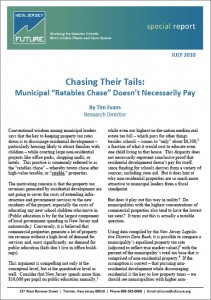Chasing Their Tails: Municipal Ratables Chase Doesn’t Necessarily Pay
Conventional wisdom among municipal leaders says that the key to keeping property tax rates down is to discourage residential development – particularly housing likely to attract families with children – while courting large non-residential projects like office parks, shopping malls, or hotels.
This practice is commonly referred to as the “ratables chase” – where towns chase after high-value taxable, or “ratable,” properties.
The motivating concern is that the property tax revenues generated by residential development are not going to cover the costs of extending infrastructure and government services to the new residents of the project, especially the costs of educating any new schoolchildren who move in. (Public education is by far the largest component of local government spending in New Jersey and nationwide.) Conversely, it is believed that commercial properties generate a lot of property tax revenue without a high level of demand for services and, most significantly, no demand for public education (kids don’t live in office buildings).
But does it play out this way in reality? Do municipalities with the highest concentrations of commercial properties also tend to have the lowest tax rates? It turns out this is actually a testable question, and Chasing Their Tails: Municipal Ratables Chase Doesn’t Necessarily Pay examines some of the results.
Download Report:
Chasing Their Tails: Municipal Ratables Chase Doesn’t Necessarily Pay (PDF)












